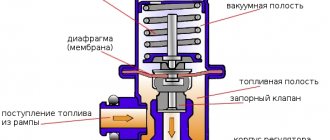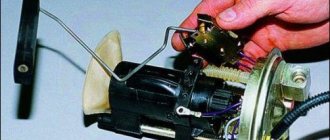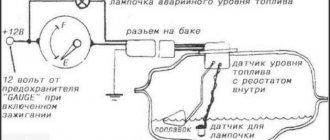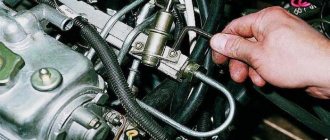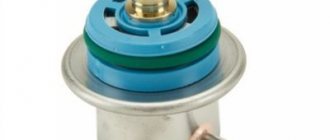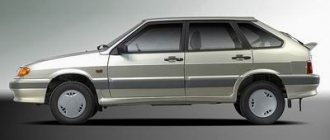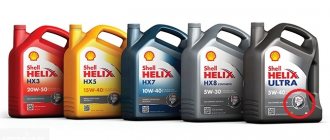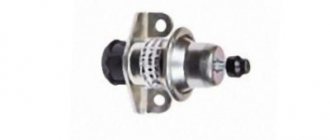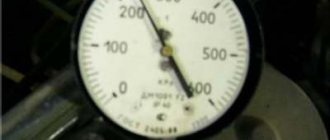Car owners are sometimes faced with the fact that there is no pressure in the fuel rail of a VAZ 2114. In order to understand the causes of this problem and how to eliminate it, it is important to understand the purpose and operating principle of this element.
VAZ fuel rail
The injection engine for the VAZ 2114 car is a power unit with distributed injection, which is carried out through injectors located on the fuel frame. What is a fuel rail? This is a hollow tube with both ends welded. The frame is attached to the engine intake manifold and has a special drain line for excess fuel.
VAZ 2114 fuel supply diagram
To maintain constant pressure in the fuel frame, the VAZ 2114 fuel pressure regulator (RDT) is designed. It is installed slightly above the ramp and has the following feature: when the power plant is stopped and the ignition is turned off, it completely shuts off the fuel supply.
At the same time, high pressure in the fuel rail is maintained for a long time, so that when the engine is turned on, gasoline enters the injectors under normal pressure and starting occurs without delay.
Fuel pressure regulator VAZ-2114: signs of malfunction, repair. Fuel system VAZ-2114
All engines with an electronic fuel injection system are equipped with devices that maintain the required fuel pressure in the fuel line.
In the VAZ-2114 power unit, this function is performed by a special regulator. It is thanks to this that gasoline is supplied under pressure to the injectors in the required quantity, depending on the operating mode of the engine. In this article we will talk about what the VAZ-2114 fuel pressure regulator is, how it works and where it is located. In addition, we will consider its possible malfunctions and methods for eliminating them.
Purpose
VAZ 2114 injectors are designed to spray fuel under pressure and mix it with air to form a fuel mixture. When fuel arrives at the injector, it is closed, as soon as the control unit sends a signal to open a certain injector, it opens, thereby fuel under pressure is sprayed and mixed with air, after which it enters the combustion chamber of the cylinder through the intake valve and is ignited by the spark plug.
Design features and principle of operation
Structurally, the VAZ-2114 fuel pressure regulator is a membrane bypass valve enclosed in a metal casing. It is mounted on the ramp and inserted into it with one of the pipes through a rubber seal. The other output of the RTD is connected to the fuel line. To determine the load on the engine, the regulator is connected to the intake manifold with a vacuum hose. Thus, on the one hand, the membrane is acted upon by fuel supplied under pressure from the fuel pump, and on the other, by air pressure and the force of the valve spring.
The VAZ-2114 fuel pressure regulator has a fairly simple operating principle. When you press the accelerator pedal, excess pressure is created in the intake manifold, which opens the valve slightly, allowing more fuel into the ramp. When the throttle valve is closed, the air pressure in the intake pipe weakens. The valve opens in the other direction, releasing gasoline back into the fuel line.
Description of the power system design
The vehicle's power system is designed to store fuel reserves, purify fuel and air from foreign impurities, and supply air and fuel to the engine cylinders.
The air entering the engine cylinders is cleaned of dust by an air filter. Air filter
installed in the engine compartment on three rubber supports. The filter element is replaceable and made of special paper. To prevent contaminated air from leaking into the intake tract, there is a sealing edging at the top of the element. To replace the filter element, the filter cover is removable. The purified air passes through the mass air flow sensor through the air duct to the throttle valve.
Throttle valve
regulates the amount of air entering the engine cylinders. The damper drive from the gas pedal is cable. The damper rotates on an axis in the housing (pipe). The throttle body is secured to the receiver flange with studs. The housing has a channel for coolant. The channel is connected to the cooling system by rubber hoses. Circulating coolant through the throttle body prevents the body's internal air cavities from freezing in the winter. The housing contains fittings for connection to the absorber and the engine crankcase ventilation system.
The throttle body, with the throttle position sensor and idle speed control installed on it, form the throttle assembly.
Throttle assembly:
1 - throttle valve drive sector; 2, 4 — fittings for connection to the engine cooling system; 3 — crankcase gas outlet fitting; 5 — throttle position sensor; 6 — idle speed regulator; 7 — fitting for connecting to the adsorber; 8 — throttle valve; 9 — throttle body pipe
Air is supplied to the intake valves of the engine cylinders through the receiver and the intake manifold.
Fuel tank
steel, welded from two stamped parts. The tank is suspended from the bottom of the car on two steel clamps. The filler neck of the fuel tank is located on the right side of the vehicle and is closed with a plug. Fuel from the tank is supplied by an electric submersible fuel pump.
The pump is installed in the fuel tank. To access the pump, there is a hatch with a cover in the bottom of the car under the rear seat cushion. A strainer is installed on the inlet pipe of the fuel pump, which traps small solid particles of debris that enter the fuel tank along with gasoline. The pump is turned on by command from the ECU.
Fuel pump:
1 — protrusion for fastening the mesh filter; 2 — fuel intake pipe for connecting a strainer; 3 - body; 4 — electrical connector block; 5 - outlet (discharge) pipe for connection to the fuel module cover with a corrugated tube
From the pump, through the corrugated tube of the fuel module (see below), gasoline enters the fuel line and then into the fuel filter, where the fuel undergoes more thorough cleaning.
The fuel filter is made of paper, installed in a non-separable metal housing. The purified fuel flows through the fuel line into the fuel rail.
Engine fuel filter 11183 (1.6i):
1 — inlet pipe; 2 - body; 3 — fuel flow direction arrow (painted on the filter housing); 4 - outlet pipe
Note. The fuel filter of the 2111 (1.5i) engine has threaded connecting pipes.
The fuel rail holds four injectors and supplies fuel to them. The connection between the ramp and the injectors is sealed with rubber rings.
The fuel pressure regulator is a bypass valve that maintains in the system (fuel line) the operating pressure necessary for proper operation of the injection system.
All cars of recent years of production are equipped with a fuel vapor recovery system (in accordance with EURO II environmental requirements), where the above-fuel space of the tank is connected to the atmosphere not directly, but through the elements of this system. The system consists of a separator, safety valve, adsorber, gravity valve, adsorber purge valve, check valve, connecting pipes and hoses. The separator and gravity valve are mounted under the right rear fender of the vehicle. In the separator, gasoline vapors are partially condensed and returned back to the fuel tank. The gravity valve prevents fuel from leaking out of the tank when the vehicle turns over. The safety (two-way) valve prevents the formation of excess pressure of fuel vapor in the tank, as well as the occurrence of vacuum there caused by fuel consumption.
Location of elements of the fuel vapor recovery system in the rear of the vehicle:
1 - safety valve; 2 - separator; 3 — plug of the filler neck of the fuel tank; 4 - gravity valve
Symptoms of RTD malfunction
A faulty VAZ-2114 fuel pressure regulator does not pose a critical threat, but its failure disrupts the stable operation of the engine. Symptoms of RTD failure may include:
- difficult starting of the power unit;
- unstable crankshaft speed at idle;
- reduction in engine power characteristics;
- loss of dynamics;
- the occurrence of “dips” when pressing the accelerator pedal;
- increase in fuel consumption.
Having discovered the listed signs of an RTD malfunction, you should diagnose the device and determine the cause of the failure.
Cleaning injectors
To clean the injectors yourself, you do not need to have great skills in car repairs; it is enough to have the desire to repair the car yourself and purchase the necessary parts to carry out this work.
For cleaning you will need:
- Carburetor cleaner;
- Syringe;
- Wire 2 m;
- Lamp 12V;
- Non-latching button (wires can be used);
- Lamp (serves as a current-limiting resistor);
- Injector connector;
- O-rings;
After all the parts are prepared, we assemble the washing device. We fill the syringe with up to half of the carburetor cleaner, and insert it into the nozzle with a diameter that fits perfectly.
We assemble a power circuit for opening and closing the nozzle. We connect everything as shown in the diagram.
Flushing
We connect the circuit to the battery and create pressure on the injector by pressing the syringe piston, as soon as pressure appears, press the button and close the circuit for 1-2 seconds, the injector will open, we repeat this procedure several times until the injector sprays fuel evenly.
Possible malfunctions of the RTD
Considering that the design of the pressure regulator is mechanical, malfunctions in its operation can occur quite often. The most common device malfunctions include:
- weakening of the membrane spring;
- valve jamming;
- regulator clogging;
- violation of the tightness of the junction of the regulator and the ramp body.
When the diaphragm spring weakens, the valve cannot cope with the air pressure coming from the intake manifold. As a result, the pressure and amount of incoming fuel are reduced.
Valve jamming leads to an uncontrolled supply of fuel to the manifold and its “waste” into the fuel line. In this case, gasoline consumption increases, and the engine stops starting normally due to interruptions in the fuel supply.
Similar signs of malfunction can be observed when the regulator is clogged. Dirt and deposits reduce the throughput of the system, as a result of which the fuel pressure decreases significantly, the engine “chokes”, and normal idle speed disappears.
If the seal between the regulator and the ramp is broken, the air pressure may drop, which again will lead to a decrease in fuel pressure.
How to remove and clean
- Turn off the fuel supply from the fuel rail.
- Disconnect the electrical connector for the fuel injectors.
- We unscrew the two bolts securing the ramp and pull it out.
- We remove the injectors from the ramp and install them in a special stand
- After cleaning, put everything back together in reverse order.
Further in our photo report there are more detailed instructions.
We begin to remove the fuel injectors for further cleaning. The injectors are located behind the intake manifold.
The first thing we need to do is relieve the fuel pressure from the fuel rail. To do this, unscrew the plastic cap indicated by the arrow in the photo.
And use something sharp to press on the spool valve, first placing a container so as not to pour gasoline all over it.
What you need to check the pressure in the system
In order to verify the serviceability (malfunction) of the RTD, as well as the entire fuel system, it is necessary to determine the value of the fuel pressure. Naturally, you will need a special tool for this.
- a piece of high pressure hose (internal diameter 8-10 mm);
- several clamps corresponding to the diameter of the hose;
- pliers;
- screwdriver;
- nipple cap;
- fuel collection container;
- dry clean rag.
Pressure measurement modes
Before checking the pressure in the fuel rail, it is a good idea to find out how this process is carried out. To be able to more accurately determine a possible malfunction, pressure measurements must be carried out in several modes:
- with the ignition on (without starting the power unit);
- with the engine running at idle speed;
- with the vacuum hose disconnected from the regulator (to check the operation of the RTD);
- with a blocked fuel return hose;
- in overdrive mode.
How to remove the fuel rail of VAZ 2114, 2115 injectors - step-by-step instructions
1. First, you need to relieve the pressure in the fuel system; to do this, you need to turn off the fuel pump. To quickly turn off the fuel pump, simply remove the fuse that is responsible for this device from the socket in the fuse block. Next, you need to start the engine and let it run until it stalls. If you don’t want to go to the fuses, then you can try to turn off the power to the fuel pump in another way, for example, by disconnecting the fuel pump power supply.
How to check fuel rail pressure
The procedure for taking pressure measurements is as follows. First, connect a fuel pressure gauge to one end of the hose and secure the connection with a clamp. We unscrew the cap on the fuel rail (on the side opposite to the one where the RTD is installed). We place a container under the fitting to collect fuel. Using the nipple cap, press the central protrusion, thus releasing the fuel pressure in the system. This process is required! Next, without removing the container, unscrew the locking nipple completely.
When the remaining fuel has drained into the container, put the other end of the hose on the fitting and secure it with a clamp. Turn on the ignition and wait until the gas pump pumps fuel into the system. We check the pressure and compare it with the recommended one.
After this, we start the engine and take measurements at idle. Checking the functionality of the fuel pressure regulator is carried out with the vacuum hose disconnected from it and with the power unit running. If the pressure has increased to 3.3 kg/cm2, the regulator can be considered operational. If it has not changed, the RTD has most likely become unusable.
Similarly, we measure pressure when the return hose is closed, as well as in the gas overflow mode.
Replacing the fuel rail on VAZ 2113, VAZ 2114, VAZ 2115
Welcome! Fuel rail - it distributes fuel to the injectors, in addition, it regulates the pressure that will be supplied through the injectors to the car engine, that is, thanks to this thing, we can say that the car drives and not only does it drive, but it drives without interruptions in engine operation, with ramp time due to bad fuel it becomes clogged, in this case it will be enough to remove it and wash it from the inside with a special liquid to clean the injector, but you can also replace it if you have extra money, but we still recommend replacing it only in cases of its deformation, when it already has injectors do not hold on when the clamps of their fastening fall off, etc.
Note! Replacing this thing is not that difficult, you just need to know some nuances, by the way, some people even remove the receiver from the car to replace it, in fact, you don’t have to remove it and immediately proceed to replacing the ramp itself, to do this you will need: Hex keys, as well as a set of wrenches, and screwdrivers, if you are going to remove the receiver (With the receiver removed, it is much easier and more convenient to change the ramp, and if it is installed, then you will also replace it, but it will just be inconvenient , but you’ll save yourself a lot of time), then you’ll also need socket heads, an extension cord for them and a wrench and even pliers will come in handy!
Summary:
Where is the fuel rail located? It is located behind the receiver (The receiver is indicated by a blue arrow), which is why all the car repair manuals (Books) say that you need to remove the receiver from the car so that it does not interfere, but whether to do this or not, as we have already told you, is at your discretion, because that the ramp can be easily removed even without removing the receiver; by the way, for clarity, in the photo below it is indicated by a red arrow.
When do you need to change the fuel rail? Only when it is deformed, but over time it needs to be cleaned, this is done using a special liquid for cleaning injectors (You can find this in a car store), namely, the ramp is removed from the car and all four injectors are also removed from it (About that how to remove the injectors, read in detail in the article: “Replacing fuel injectors on a VAZ”) and then the inside of the ramp is washed with this liquid (The liquid can be driven into the ramp through the holes where the injectors were installed) from dirt and other types of slag.
Note! If something happens to the ramp (clogged or deformed), then in this case the symptoms will be as follows: the car will jerk when driving, will not gain normal speed (power will drop), also at idle the engine may stall, it may still be difficult to start, its fuel consumption will also increase (These symptoms are very common and can occur not only because of the ramp, but also because of the fuel pump, because of the injectors, because of the fuel pressure regulator, etc., so if they you will appear, it is not worth immediately making a verdict that it was the ramp that failed, because this could cause problems due to other units)!
Replacing the RTD
The RTD can be replaced either with the fuel rail removed or without dismantling it. The latter option is more preferable as it requires less time. But before removing the fuel rail or the regulator itself, do not forget to reduce the pressure in the system as described above! Otherwise, the entire engine compartment will be splashed with gasoline.
So, let's look at how to replace the VAZ-2114 fuel pressure regulator without dismantling the ramp. For this you will need:
- key to “10”;
- key to "17";
- key to “24”;
- hexagon to “5”;
- screwdriver with Phillips bit;
- clean dry cloth.
How to replace the fuel rail on a VAZ 2113-VAZ 2115?
Note! On cars of the Samara 2 family, different engines were installed and different fuel rails were also installed, but don’t pay much attention to this, and even if you have a ramp of a different type (on engines 21114 there is a ramp like the one shown in the pictures below), then the principle of removing it is practically is identical to other ramps (In this article we are looking at replacing the fuel rail of the 2111 engine) and therefore, by turning on your head and studying this article in detail, you can replace this ramp on your car!
Removal: 1) Before proceeding to removal, release all the pressure in the system using a screwdriver and the fitting that is present on the fuel rail (For more details on how to do this, read the article: “Relieving pressure on a VAZ”), after the pressure will be released from the system, you can proceed to the replacement itself, first disconnect the wire block and the connector between each other that goes to the injectors (see photo below), it is located next to the fuel pressure regulator, look more carefully and you will find it immediately , by the way, as soon as these things are disconnected from each other, remove the fuel pressure regulator itself from the rail (For information on how to do this, read the article: “Replacing the fuel rail pressure regulator on a car”).
Note! Before disconnecting the wires, it is advisable to remove the minus terminal from the battery so that no short circuit occurs. If you do not know how to remove the terminal from the battery, then in this case, study point one in the article entitled: “Replacing the battery on a VAZ”, which is located on our website!
2) Now unscrew the nut securing the fuel pipe to the side of the ramp (Indicated by a red arrow) and then disconnect the tube from the ramp, once it is disconnected, inspect the o-ring on its tip (Indicated by a blue arrow) which should be in normal condition and not in no case should there be any defects on it (cracks, tears, or the ring should not lose elasticity, in other words, make sure it is not hardened), if necessary, replace it with a new one.
3) Next, using a “5” hex wrench, unscrew the two hex head bolts (see photo 1), which secure the fuel rail to the brackets; after unscrewing, carefully remove them and do not lose the washers, which are located under the bolt heads, and in completion, carefully remove the ramp, but only it must be removed at the beginning at an even angle so that the injectors are not damaged, that is, the fuel injectors fit into the holes, if you immediately begin to pull the ramp to the side, the injectors will simply bend and break due to this, so at the beginning Carefully, without changing the lines to the top, remove the fuel rail and only after that tilt it as convenient for you and pull it out together with the injectors from the place where it is located.
Note! If, when removing the ramp, it happened that the injector remained sitting not on the ramp itself, but in the hole into which it goes, then in this case the clamp that holds this injector must be replaced and the sealing ring of this injector must also be replaced, by the way, in more detail how to replace these clamps and O-rings on the injectors, read the article to which the link is given above, and this article is called: “Replacing fuel injectors on cars”!
Installation: The new ramp is installed in its place in the reverse order of removal; before installing from the old ramp, remove all the injectors and transfer them to the new ramp, and also leave all the latches in good working order, over time they will weaken and you have to replace them with new ones.
Additional video clip: So that you can clearly see the process of replacing the ramp, in this case, study the video that is located just below, it shows the whole example on the 2111 engine, this is an engine with a volume of 1.5 liters, 8 valves, used on cars of the Samara, Tenth family family and family Samara 2.
Source
Work order
- First, disconnect the negative terminal from the battery (key to “10”).
- Disconnect the regulator vacuum hose from the intake manifold fitting.
- Using a “17” wrench, unscrew the nut securing the drain hose. Disconnect the hose.
- Using a Phillips screwdriver, unscrew the bolt of the return pipeline clamping plate.
- Using a hex wrench set to “5”, unscrew the screws securing the RTD to the fuel rail.
- Using a “24” wrench, unscrew the nut connecting the drain hose fitting and the RTD.
- Remove the fuel pressure regulator.
That's basically the whole process. Installation of the RTD is carried out in the reverse order. Important: do not lose the rubber seal that comes with the regulator. Without it, the connection between the RTD and the fuel rail will be leaky, which will lead to a change in the operating pressure in the system.
How to remove the fuel rail of VAZ 2114, 2115 injectors - step-by-step instructions
1. First, you need to relieve the pressure in the fuel system; to do this, you need to turn off the fuel pump. To quickly turn off the fuel pump, simply remove the fuse that is responsible for this device from the socket in the fuse block. Next, you need to start the engine and let it run until it stalls. If you don’t want to go to the fuses, then you can try to turn off the power to the fuel pump in another way, for example, by disconnecting the fuel pump power supply.
2. Next, turn off the ignition.
3. Disconnect the negative terminal of the battery.
4. Disconnect the air receiver hose, as well as the vacuum hose from the pressure regulator.
5. Using a wrench set to “17” (some have a wrench set to “22”), unscrew the fittings and move the tubes to the side.
6. Then disconnect the fuel rail power wires.
7. Next, remove the clamping bar securing the fuel pipes.
8. Take the hexagon at “5” and use it to unscrew the two bolts securing the fuel rail.
9. Remove the injectors from their sockets, while slightly pulling the ramp along the axis.
10. Now you can remove the fuel rail from the car. Be extremely careful and careful not to damage the contacts of the injector connectors and sprayers. Make sure that nothing, such as dirt or dust, gets into the channels or fuel lines.
11. When unscrewing the union nut, hold the fitting using a second wrench.
12. Cleaning the ramp from dirt should be done exclusively with a special liquid for cleaning fuel cells (ABRO, WD-40).
This completes the removal procedure, all that remains is to carry out repair work, replace faulty parts and reassemble everything in reverse order. Thank you for your attention, see you again at VAZ Repair!
Source
Some useful tips
To ensure that the fuel pressure regulator does not cause you trouble and works as long as possible, use these tips.
- When planning to replace an RTD, buy only a branded device recommended by the manufacturer.
- Fill your car tank with only high-quality fuel. Do not use fuel additives of unknown origin.
- Do not forget to promptly replace the fuel filter.
- At each maintenance check the fuel pressure in the system. If problems are identified, correct them promptly.
- If you find problems with the regulator, do not delay replacing it.
Source
COMPONENTS OF THE DEVICE
The VAZ 2114 fuel system includes:
- fuel mixture storage tank;
- gasoline pump;
- several types of filters;
- pipelines for transmitting flammable liquids;
- ramp with 4 nozzles;
- pressure regulator;
- cap on the tank neck.
The steel fuel tank serves as an object for storing fuel; it contains a high-pressure pump and a fuel availability indicator controller, which transmits a signal to the control panel. The pump has a coarse filter that prevents large particles of debris, rust and various impurities from entering the fuel system.
There is a fine filter near the tank; this unit guarantees thorough cleaning of the flammable liquid from the main line to the nozzles.
The injectors are placed on the fuel rail, which securely fastens them to the engine. Fuel injection is carried out using the system control unit. The pressure regulator controls the level of fluid injection between the inlet hose and the ramp line. The excess combustible mixture is returned back through the nozzles, along a separate tank drain line.
The temperature of the fluid that performs the reverse stroke increases by 6-14 degrees, this happens because the fuel circulates under the base of the machine and the blazing engine, and also rubs against the walls of the hose.
This circulation of the combustible mixture increases the temperature of the total liquid in the tank. Fuel vapors appear, which, according to a certain pattern, enter the fuel container and do not escape into the atmosphere; the fuel injection system ensures the safe capture of evaporation, destroying the vapors during engine operation.
Before carrying out repairs or preventative actions on the power system, it is important to reduce the pressure inside the unit. To prevent fuel spillage when removing the wires, it is important to secure the ends of the hose with microfiber.
The vehicles are equipped with a VAZ 2114 fuel supply system, which effectively supplies fuel at various inclinations of the vehicle, as well as when the liquid level in the tank is low.
Fuel pressure sensor VAZ 2114: diagnostics and replacement
The VAZ 2114 fuel pressure sensor is today’s topic of conversation. I accidentally came across a question from a person who is having difficulty starting the engine. And I changed several fuel pumps, but it didn’t do much good.
The electric pump works, but it feels like it’s not pumping at all. Let's try to figure out what could be the reason? And is it worth blaming the pump right away? Yes, if the “diaper” is clogged and has never been changed, then it’s worth taking it off and seeing what’s going on there?
But if everything is fine here, you should pay attention to a small element that has a huge impact on the fuel supply - the check valve, also known as a pressure sensor. Let's talk about it now.
Removing and replacing injectors
Before dismantling the injectors on the VAZ-2114, you will need to relieve the pressure in the fuel rail. The process is performed by disconnecting the connectors with wires from the fuel pump and then starting the engine. The machine should run in this position until it stalls. The procedure must be repeated until the car can start.
Disconnect the connector with wires from the fuel pump
Disconnect the electrical connector from the fuel rail
Unscrew the gasoline supply pipes
Use a screwdriver to unscrew the bracket on which the fuel pipes are attached.
Removing the fuel rail
Remove the injector from the fuel rail hole
Important! If the nozzle will be washed, it is not recommended to place it in a dirty place.
- It is better to cover the ramp and the holes in it with something to prevent dirt and other objects from getting in there.
Replacing the injector is quite simple. When the old spare part is removed, install a new one and secure it with a spring washer . After this, you can put the ramp in its place.
Video about removing and installing injectors
Replacement Tips
It is important to remember that you should be extremely careful when dismantling and installing injectors.
Service workers always advise adherence to the following points when replacing:
- Do not damage the injector when replacing.
- It is prohibited to disassemble injectors for repairs.
- You need to make sure that no oil gets inside.
- It is strictly forbidden to immerse parts in any cleaning products. They have electrical connections in the middle.
- There is no need to rush to part with money for new parts; perhaps the problem can be solved by simply flushing the channels.
- To do this, it is recommended to watch a video on proper washing.
Video about proper injector cleaning
Fuel pressure sensor VAZ 2114: main functions
Like most pressure sensors, this one is also a membrane type. Installed in the fuel rail, next to the injectors. Its function is to maintain pressure in the rail in a certain operating range. This is especially true not for a steady state, but for a changing operating mode. Using the regulator, the load on the engine is adjusted. Let’s say that when the pressure in the intake tract decreases, the pressure of the air-fuel mixture increases. And vice versa - when it increases, it decreases. Three important points can be highlighted:
- It changes the pressure when it also changes up or down in the intake tract.
- Allows you to maintain the pressure in the VAZ 2114 ramp in a certain range.
- Under various operating modes, the internal combustion engine helps compensate for loads.
Pressure in the fuel line VAZ 2114
The pressure in the fuel line of an injection engine is an important parameter - if it is low, normal injection by injectors into the cylinders of an internal combustion engine (ICE) will not be ensured. And its high degree is also dangerous - fuel can flood the entire engine compartment, and then a fire will occur.
Car owners may have a question about how to check the pressure in the fuel rail, within what limits should the readings be, what is used to check it, and how to determine what may be faulty in the fuel line? So, in order.
First you should know how the fuel system (TS) works and what elements it consists of. The vehicle includes (elements in order, starting from gasoline intake to its direct injection):
- Gas tank (in the VAZ model 2114 it is located under the bottom of the trunk);
- Electric fuel pump (located in the gas tank);
- Coarse filter (represents a mesh that is located on the intake part of the pump);
- Fine filter (located immediately after the gas tank, located below the trunk, between the rear of the muffler and the fuel tank);
- Fuel rail or rail (TR), it distributes gasoline among the cylinders, it can be steel, aluminum or plastic;
- Injectors (there are four on model 2114);
- Fuel pressure regulator (it maintains the required gasoline pressure in the system for normal injection through the injectors into the cylinder).
All elements are connected to each other by a fuel line, and in the entire chain, after the pressure regulator (RDT), there is also a return hose through which excess gasoline is discharged into the tank. After the ignition is turned on, fuel passes through the system to the injectors (therefore, there is pressure in the system even when the ignition is on), and when the engine starts, the electronics send a command to the injectors, and gasoline enters the cylinders.
How and with what to check the pressure in a vehicle
They check the pressure in the fuel rail of the VAZ 2114 with a pressure gauge - it is most convenient to connect it on the ramp, and not somewhere else in the line. At the rear of the ramp, in the direction of travel of the car, there is a fitting with a thread and a valve, closed with a plastic cap. When measuring, the pressure gauge adapter is screwed onto the fitting. The pressure gauge is easy to assemble yourself. For this you will need:
- The measuring device itself with an arrow - a tire pressure gauge with a maximum reading limit of 6 to 10 kgf/cm² is suitable;
- A piece of gasoline hose 50-70 cm long;
- A fitting for checking the pressure, which will be screwed into the ramp;
- Two clamps.
We assemble all the elements, tighten the clamps, and the pressure gauge is ready for use. That's it, now you can take measurements. To do this you will need tools:
- Wheel valve cap.
- Thin screwdriver or metal pin;
- A wrench with a fitting size (usually 17 mm):
- Pressure gauge.
To measure the pressure in the fuel rail, you need to:
- Turn off the engine, turn off the ignition;
- unscrew the cap, relieve pressure in the VAZ 2114 fuel rail by pressing the valve with a thin screwdriver;
- Unscrew the spool with the valve using the wheel valve cap. A rag will come in handy - when you dump it, fuel will spray out of the valve. To relieve pressure, you need to press the valve smoothly, releasing the pressure;
- secure the pressure gauge fitting with a wrench to the rail. Now you can start the internal combustion engine and measure the pressure in the fuel rail.
The most common device malfunctions
One of the possible symptoms was discussed above - constant “idle” operation of the electric pump. In this case, the VAZ 2114 fuel pressure sensor is, of course, completely faulty, and further operation of the vehicle is not possible. But in case of minor defects, the following symptoms will appear:
- Increased gasoline consumption.
- Engine stops, unstable idle.
- A noticeable decrease in the vehicle's traction characteristics.
- Difficulty starting the engine.
As a rule, if the fuel pressure sensor on a VAZ 2114 car fails, gasoline does not flow into the return line. Consequently, excess fuel remains in the rail and the pressure is pumped up to the maximum value. But a reverse breakdown can also occur - when the fixation disappears and the pump constantly pumps gasoline in a circle, while the pressure in the ramp decreases. And at idle speed, the engine’s performance can be more or less satisfactory, but when it increases, it begins to choke, it lacks “food”.
Operating principle and typical failures
A fuel pump is a kind of small electric motor that pumps fuel and creates pressure in the fuel rail of a VAZ 2114 car. The pump is a component of the fuel module.
Structurally, the pump and electric motor are a single unit. Its electrical part is washed with fuel, which provides cooling, plus lubricates the surfaces that come into contact with each other.
Fuel pump VAZ 2114
There are many signs of breakdowns, which indicate a failure or malfunction in the fuel system, or more precisely the fuel pump. Almost every person is able to detect some of them:
- The engine does not start;
- When you try to start the engine, you cannot hear the electric motor;
- The engine runs intermittently;
- Jerking occurs when moving at low speed.
Causes
As for the reasons why the fuel pump fails, they may be:
- Fuse on the pump is broken;
- Failed relay;
- Failure of the pump electric drive;
- Poorly secured block masses;
- Damage to the pump itself;
- Missing or poor contacts at the motor terminals.
In fact, it is extremely rare for an electric motor to break down. This is due to the active cooling of the element by fuel, which not only cools, but also flushes all its components.
Shidron blower and mesh
But the centrifugal gate hydraulic supercharger suffers more often than others. The reason is small contaminants in the fuel, which end up inside the mechanism, rub against the structure and wear them out. The performance of the unit drops, the pressure decreases. This leads to the formation of the first signs of pump wear, operation noise increases, and the engine refuses to start. It is impractical to repair a broken pump; it must be completely replaced.
DIY diagnostics
Without testing, an accurate diagnosis cannot be made. So let's look at how to do it correctly. In the case of VAZ 2114 cars and similar models, it is wiser to use the simplest diagnostics - using a mechanical pressure gauge. The order is as follows:
- Unscrew the plug located on the fitting. Pay attention to the elasticity of the O-ring.
- Unscrew the spool in the same way as from the wheel chambers.
- Attach the pressure gauge using a suitable clamp to the fuel rail fitting and take measurements in various engine operating modes.
Immediately before checking the pressure control mechanism, inspect it carefully. There are marks on it showing normal pressure values for several operating modes of the VAZ 2114 internal combustion engine. If the measured values differ greatly from the reference values, the pressure regulator must be replaced with a new one.
Troubleshooting an injector with a multimeter
- Remove the negative terminal from the battery.
- Remove all connectors from the injectors.
- Connect the multimeter probes to the injector contacts.
- 11-15 Ohms on the multimeter indicate that the injector is working, and if it is more or less, it needs to be replaced.
The reason for the loss of injector performance is most often foreign impurities in the fuel. The quality of Russian gasoline is not at a high level and the sprayers do not work as expected. Repairing them is not effective due to the design features. Therefore, replacing all injectors and sealing gaskets is the only alternative option.
Installing a new sensor
Before removing, be sure to relieve the fuel pressure in the rail. To do this, turn off the power to the fuel pump and start the engine. Or carefully unscrew the spool valve from the fitting in the ramp (this option will be more suitable if the internal combustion engine does not start at all). Then you work according to this scheme:
- Disconnect the negative terminal from the battery.
- Disconnect the hose from the VAZ 2114 vacuum pump.
- Unscrew the nuts and drain the gasoline. Please note that there may still be pressurized gasoline in the fuel system. Therefore, take precautions.
- Fix the tube and washer.
- Unscrew the bolt screwed into the clamping element.
- Remove the clamping element.
- Unscrew the nut that holds the drain hose and pressure sensor.
- Remove the bolts connecting the fuel rail to the pressure sensor.
- Dismantle the pressure regulator in the system.
Install the new device in the reverse order. As you can see, there is nothing complicated. The main thing in repair is to imagine what this or that element of the system is responsible for. And then you can quickly give an accurate diagnosis based on the signs.
Source
Features of the engine power system 11183 (1.6i)
Receiver
engine 11183 (1.6i) is made of plastic.
Engine Intake Module 11183 (1.6i):
1 — flange with an o-ring for fastening the throttle pipe; 2 - receiver with o-rings for connection to the inlet pipeline
Engine Fuel Module 11183 (1.6i):
1 — inlet pipe (for supplying fuel to the pressure regulator); 2 - outlet (discharge) pipe; 3 — module cover; 4 — fuel level indicator sensor; 5 - intake chamber; 6 — module cover guide
Fuel pump
combined with a fuel level indicator sensor and a fuel pressure regulator into a single unit -
a fuel module
(often called an electric fuel pump). Fuel from the pump (through the outlet pipe of the fuel module) enters the fuel filter. Purified gasoline is again supplied through the fuel line and through a tee to the inlet pipe of the fuel module, and then supplied to the fuel rail.
Engine fuel pressure regulator 11183 (1.6i):
1 — hole for dumping excess fuel; 2, 4 — sealing rings; 3 — holes for supplying fuel to the regulator; 5 — body; 6 - terminal for connecting the regulator to ground
Fuel rail for engine 11183 (1.6i) complete with injectors:
1 — diagnostic fitting; 2 - fuel rail; 3 — fitting for connecting to the fuel line; 4, 5, 6 and 7 - injectors
Excess fuel is released through the pressure regulator into the tank. The fuel pressure regulator is installed in the fuel module cover.
